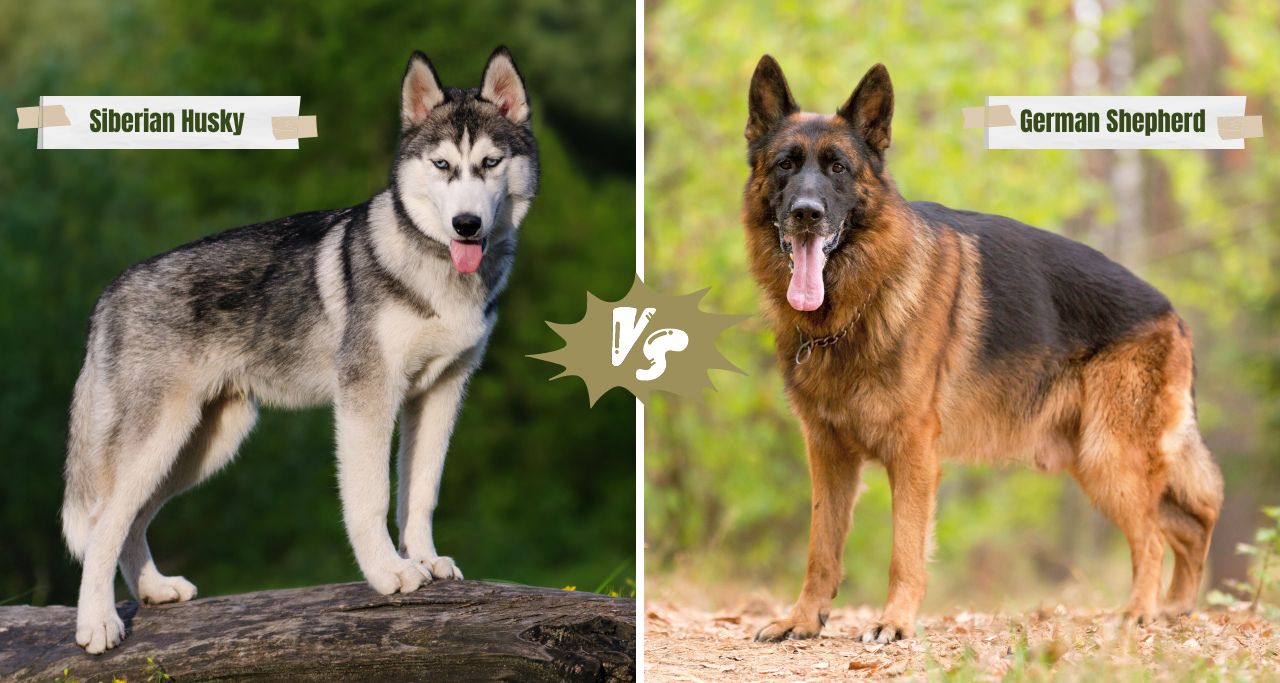
The Siberian Husky and the German Shepherd are two of the most popular dog breeds in the United States, known for their striking appearances, intelligence, and loyalty.
While both breeds have a strong following, they each bring their own unique characteristics to the table, which can make choosing between them a difficult decision for potential dog owners.
In this comprehensive comparison, we’ll explore the physical attributes, temperament, training needs, and more for both the Siberian Husky and the German Shepherd, helping you make an informed decision about which breed may be the best fit for your household.
Whether you’re looking for a loyal companion, a dedicated guard dog, or an energetic playmate, understanding the key differences and similarities between these two breeds will give you the insights you need to choose the perfect furry friend for your family.
| Breed Comparison | Siberian Husky | German Shepherd |
|---|---|---|
| Weight | 35 - 60 pounds | 50 - 90 pounds |
| Height | 20 - 23.5 inches | 22 - 26 inches |
| Size | Medium | Medium to large |
| Temperament | Playful, outgoing, mischievous | Intelligent, loyal, courageous |
| Trainability | 3.0 out of 5.0 stars3.0 | 4.0 out of 5.0 stars4.0 |
| Energy Level | 5.0 out of 5.0 stars5.0 | 5.0 out of 5.0 stars5.0 |
| Life Expectancy | 12 - 14 years | 7 - 10 years |
| Shedding | 4.0 out of 5.0 stars4.0 | 5.0 out of 5.0 stars5.0 |
| Hypoallergenic | No | No |
| Puppy Costs | $1,000 - $2,500 | $800 - $10,000 |
| Suitable For | Best for active families who can provide them with regular exercise and mental stimulation. They thrive in homes with secure yards and are excellent companions for those who enjoy outdoor activities. | Ideal for active families or individuals who can offer consistent training and companionship. They are particularly well-suited for those seeking a loyal and protective watchdog. |
Historical Background: Husky vs. German Shepherd
Siberian Husky: Origin and Early History
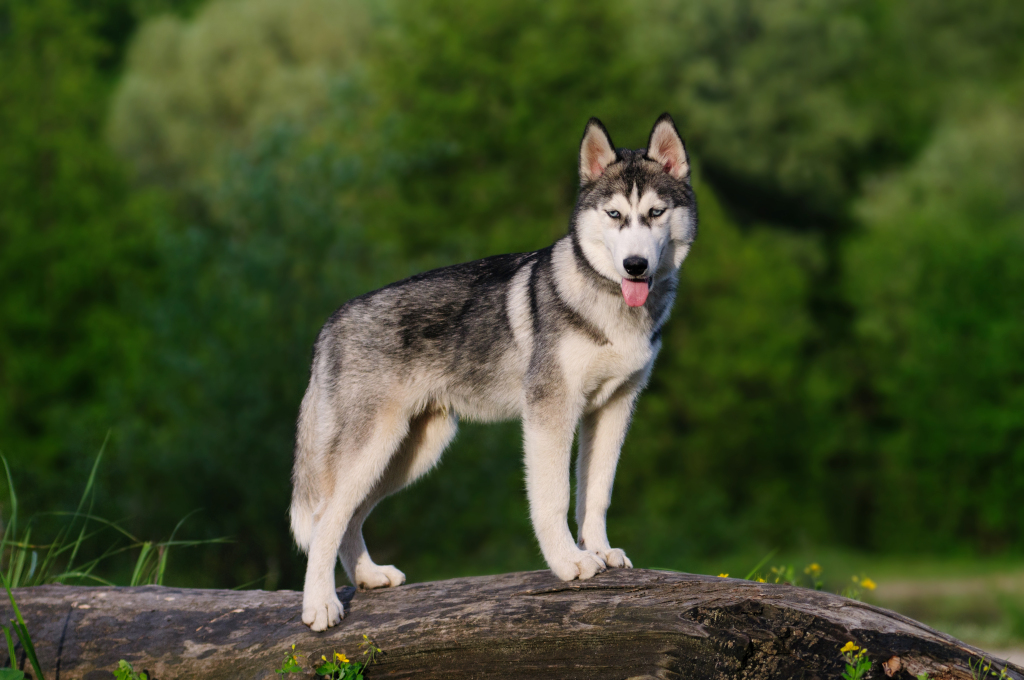
The Siberian Husky has its roots in the harsh climate of Northeast Asia, where it was bred by the indigenous Chukchi people of Siberia. These dogs were used primarily for pulling light loads over long distances in extremely cold weather.
They were an essential part of the Chukchi lifestyle, providing transportation and companionship. The breed was known for its endurance, strength, and ability to work well in a team.
In the early 20th century, Huskies were brought to Alaska for sled dog racing, where they quickly gained popularity due to their speed and stamina. Their friendly disposition and striking appearance have made them a beloved breed worldwide.
German Shepherd: Origin and Early History
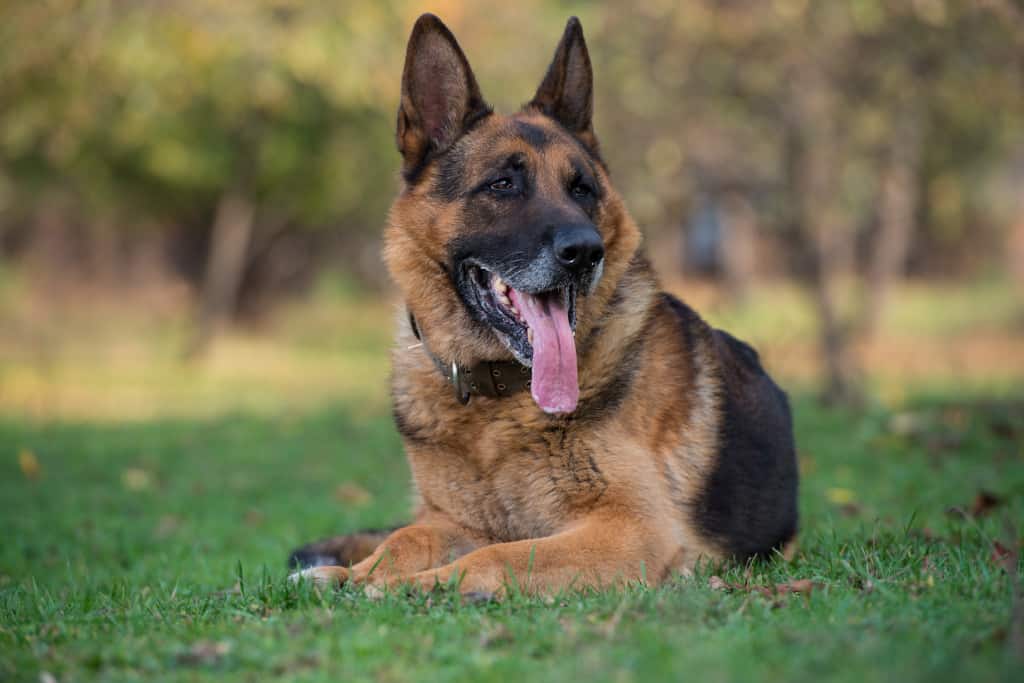
The German Shepherd’s history dates back to the late 19th century in Germany, where they were developed by Captain Max von Stephanitz.
He aimed to create a versatile working dog with intelligence, strength, and loyalty, and the breed was a result of crossbreeding various German herding dogs. The German Shepherd quickly became known for its ability to learn commands, protect property, and assist with herding livestock.
During World War I and II, the GSD’s skills were put to use in various roles, such as messenger dogs, rescuers, and guards. Their loyalty, intelligence, and versatility have made them a popular choice for police, military, search-and-rescue work, and beloved family pets.
| Attribute | Siberian Husky | German Shepherd |
|---|---|---|
| Origin | Siberia | Germany |
| Original Purpose | Sled pulling & transportation | Herding livestock & guarding property |
| Bred by | Chukchi people | Captain Max von Stephanitz |
| Primary Use Today | Family pets, recreational sled dog racing | Family pets, police, military, search-and-rescue |
| Key Traits | Endurance, strength, teamwork | Intelligence, loyalty, versatility |
| Year Recognized by the American Kennel Club | 1930 | 1908 |
** Comparison Table: Siberian Husky vs. German Shepherd - Historical Background
Comparing Physical Characteristics
Siberian Husky
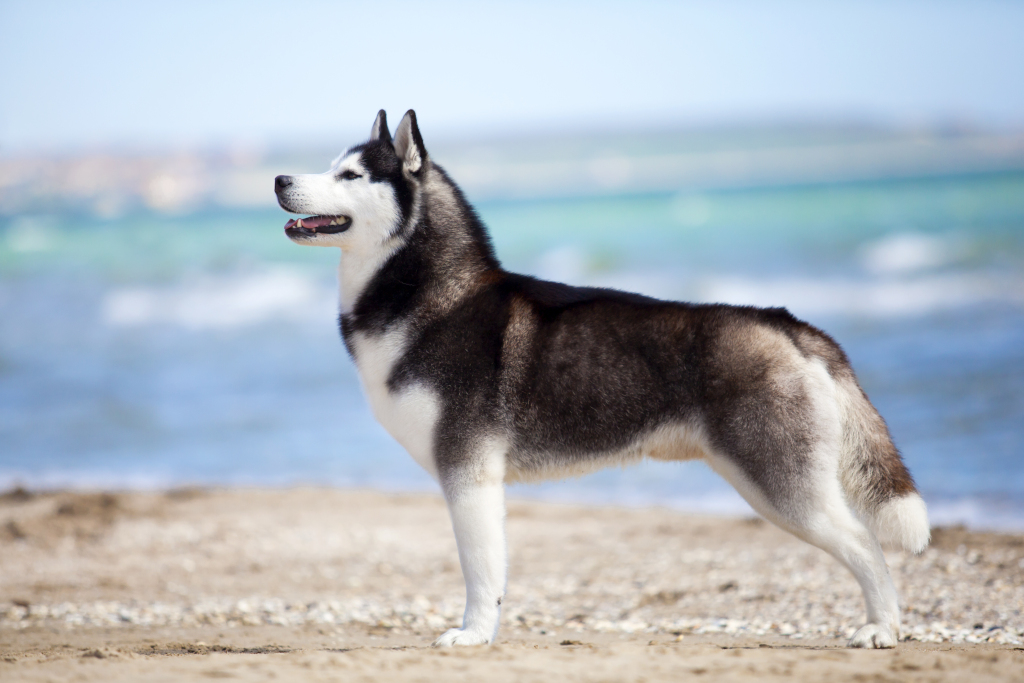
Huskies are medium-sized dogs with a muscular yet nimble build that is well-suited for endurance and agility.
Male Huskies typically weigh between 45 and 60 pounds, while females weigh slightly less at 35 to 50 pounds. They stand approximately 20 to 23.5 inches tall at the shoulder.
One of the most distinctive features of the Siberian Husky is its eyes, which can be blue, brown, or even one of each. Their almond-shaped eyes give them a sharp and intelligent expression.
The Siberian Husky’s coat is medium in length, dense, and double-layered, providing insulation from both cold and heat. The breed can come in various colors, including:
- Black & White
- Gray & White
- Agouti & White
- Black & White
- Red & White
- Sable & White
- Seal & White
- Silver & White
- Blue & White
- White
Their guard hairs are straight, with a softer, dense undercoat that provides insulation against cold temperatures.
German Shepherd
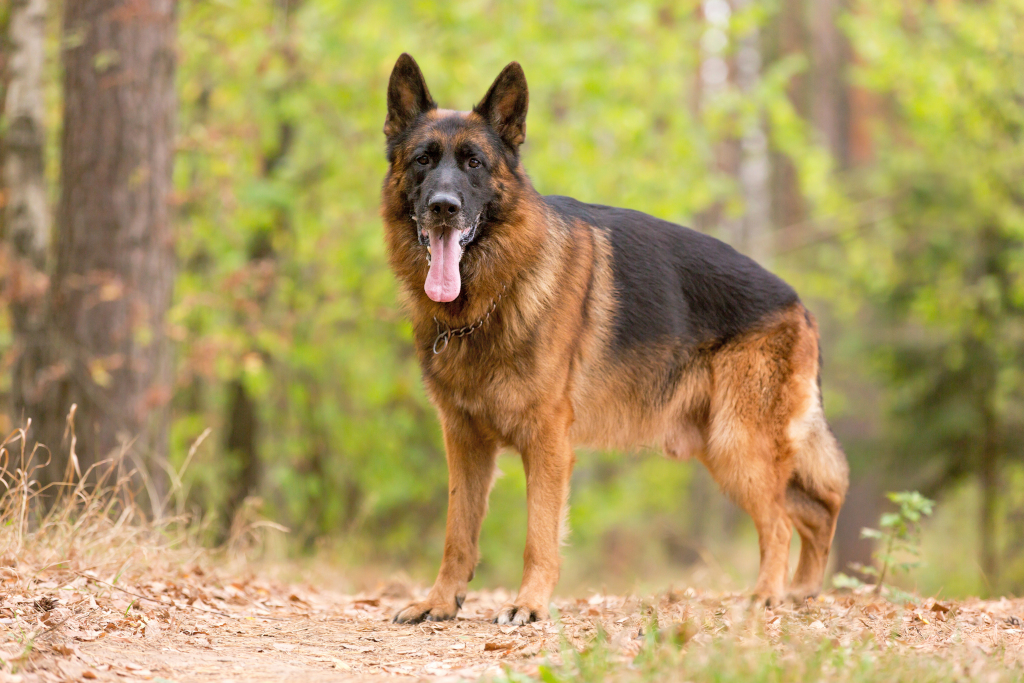
German Shepherds are larger and more robust dogs known for their strength and versatility.
Male German Shepherds typically weigh between 65 and 90 pounds and stand 24 to 26 inches tall, while females weigh between 50 and 70 pounds and stand approximately 22 to 24 inches tall.
They have a sturdy build with a deep chest, strong back, and well-muscled legs, giving them a powerful and agile appearance.
The German Shepherd’s coat is dense, straight, and harsh to the touch, with a thick undercoat that provides protection against harsh weather.
GSDs can come in various colors, including:
- Black & Cream
- Black & Red
- Black & Silver
- Black & Tan
- Black
- Gray
- Sable
- White
- Liver
- Blue
- Bi-Color
Their fur is generally medium-length but can be long, though too long of the outer coat is considered a fault as per the AKC breed standard.
You May Also Like: Think You Know German Shepherds? Discover Their Surprising Varieties
| Attribute | Siberian Husky | German Shepherd |
|---|---|---|
| Size | Medium | Medium to large |
| Male Weight | 45 - 60 lbs | 65 - 90 lbs |
| Male Height | 21 - 23.5 inches | 24 - 26 inches |
| Female Weight | 35 - 50 lbs | 50 - 70 lbs |
| Female Height | 20 - 22 inches | 22 - 24 inches |
| Eye Color | Blue, brown, heterochromia | Brown |
| Coat Colors | Agouti & White, Black & White, Gray & White, Red & White, Sable & White, Brown & White, Black Tan & White, White, Black | Black & Cream, Black & Red, Black & Silver, Black & Tan, Black, Gray, Sable, White, Liver, Blue, Bi-Color |
** Comparison Table: Siberian Husky vs. German Shepherd - Physical Appearance
Temperament Differences
Siberian Husky Personality
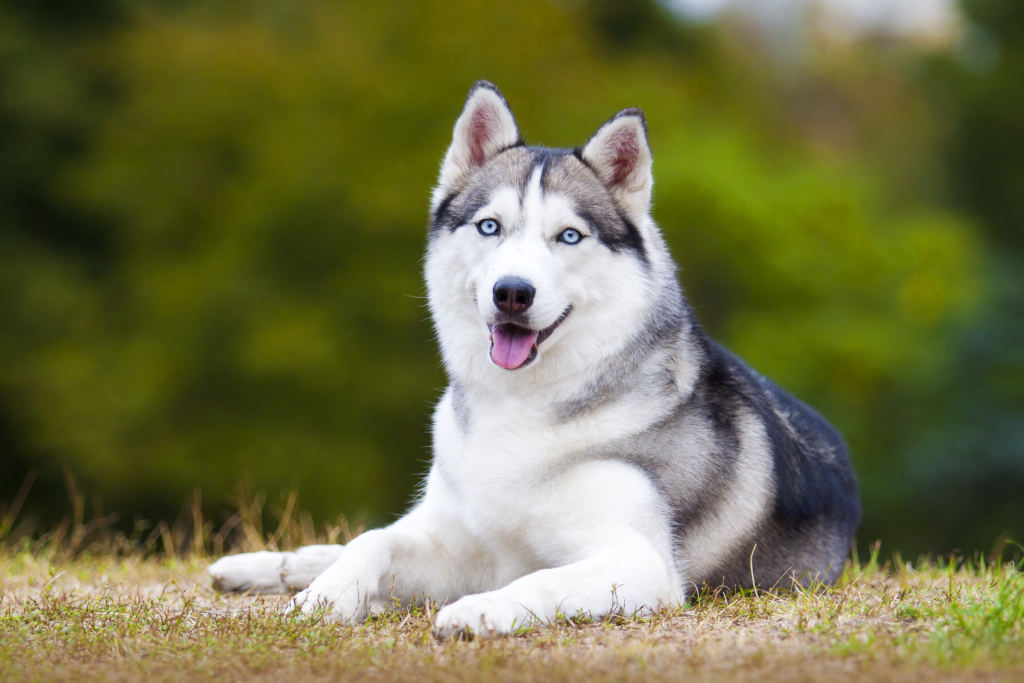
Siberian Huskies are known for their playful, outgoing, and sociable nature. They are friendly dogs that usually get along well with people and other animals.
Huskies are also known for their intelligence and independence, which means they can be stubborn and make them a bit challenging to train at times.
They are pack dogs, so they tend to be more comfortable with companionship, whether it’s other dogs or their human family. While they can be affectionate, they are not overly clingy and tend to enjoy a degree of independence.
Additionally, Siberian Huskies are known for being escape artists. They have a natural curiosity and a desire to explore, which may lead them to try to escape from yards or enclosures if given the opportunity.
You May Also Like: Train Your Dog To Stay In An Unfenced Yard: Step-By-Step Guide
German Shepherd Personality
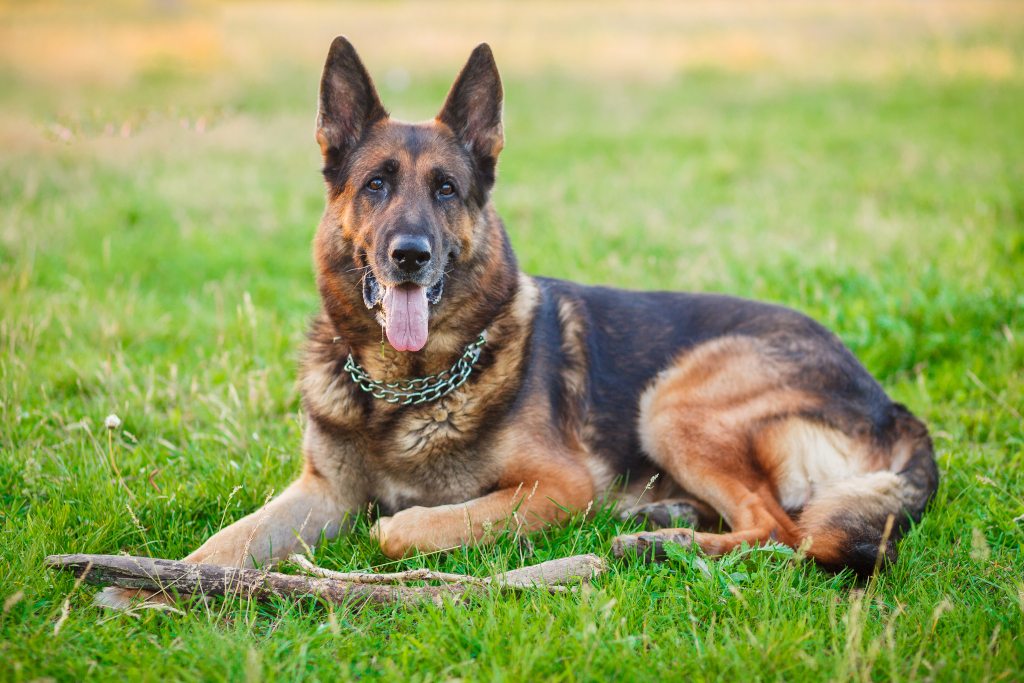
GSDs are known for their intelligence, loyalty, and protective nature. This breed is highly trainable and can excel in various roles, from police and military work to obedience competitions and service roles.
They are not as playful as Huskies, often aloof with strangers, but tend to be loving and devoted to their families. GSDs are also alert, watchful, and courageous, making them excellent guard dogs.
Bred to be a herding dog, German Shepherds have a strong work ethic and thrive when given a job, so activities that provide them with a sense of purpose and challenge their intelligence and problem-solving skills are highly beneficial.
| Attribute | Siberian Husky | German Shepherd |
|---|---|---|
| Playfulness | Very playful | Moderately playful |
| Friendliness | Friendly with people and other pets | Loyal to family, aloof with strangers |
| Independence | Likes companionship but enjoys independence | More reserved, extremely loyal to owners |
| Guarding Instinct | Low | High |
** Comparison Table: Siberian Husky vs. German Shepherd - Temperament and Personality
Energy Levels and Exercise Needs: German Shepherd vs. Husky
Siberian Husky
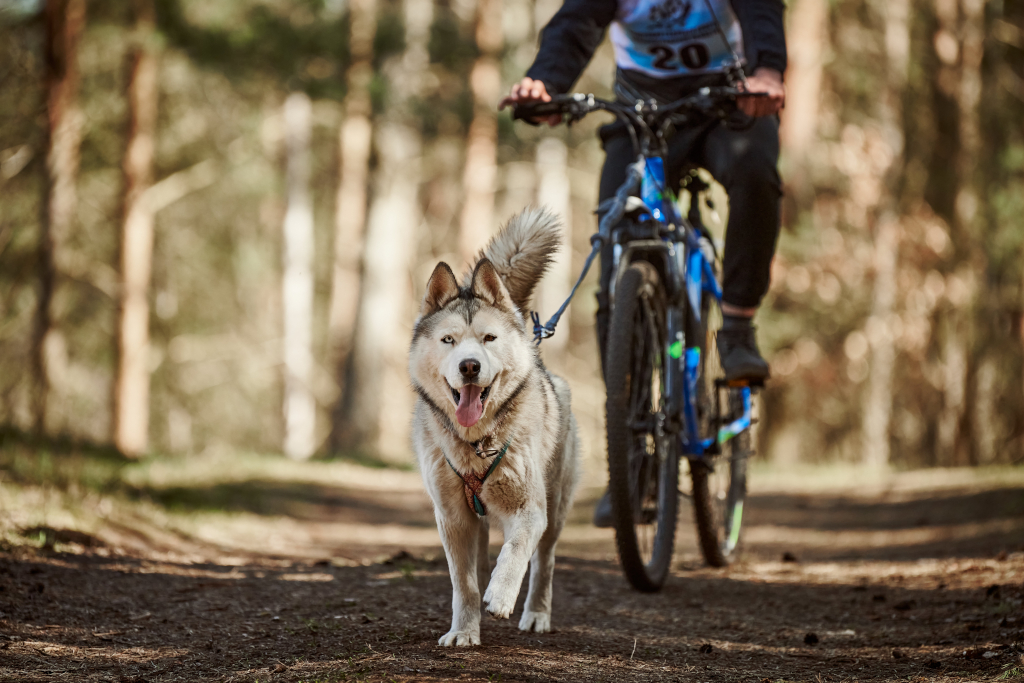
Siberian Huskies, known for their endurance and speed, were originally bred for long-distance sled-pulling in harsh Arctic conditions. As a result, they need at least two hours of exercise per day to satisfy their innate drive.
Activities like sledding and skijoring not only provide them with the physical exertion they crave but also indulge their historical role as sled dogs. These activities are more than just exercise for a Husky; they’re a return to their roots.
Apart from these activities, Huskies also love a good run or a long hike, especially in cooler weather. Without the right amount of exercise, they can become bored and may resort to digging or excessive barking.
You May Also Like: Best Dog Joring Equipment For Skijoring
German Shepherd
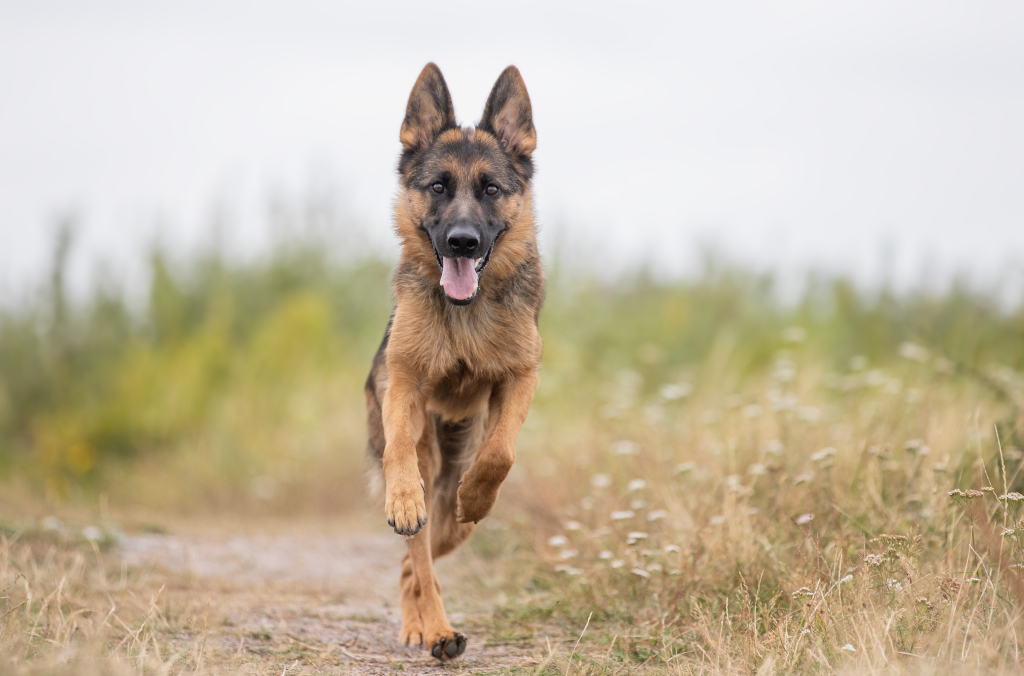
Like Huskies, German Shepherds are highly active dogs, and they, too, require a minimum of two hours of exercise daily.
Activities that engage both their body and mind, like obedience training, agility courses, and herding trials, are ideal for German Shepherds.
When they don’t get enough exercise, they may become restless and exhibit destructive behaviors.
You May Also Like: Tips To Prevent Destructive Behavior In Dogs
| Attribute | Siberian Husky | German Shepherd |
|---|---|---|
| Energy Levels | High | High |
| Daily Exercise Needs | 2 hours | 2 hours |
| Recommended Activities | Walking, running, sledding, snowshoeing, skijoring | Walking, jogging, biking, agility, herding |
** Comparison Table: Huskies vs. German Shepherds - Energy Levels and Exercise Needs
Training and Socialization
Siberian Husky
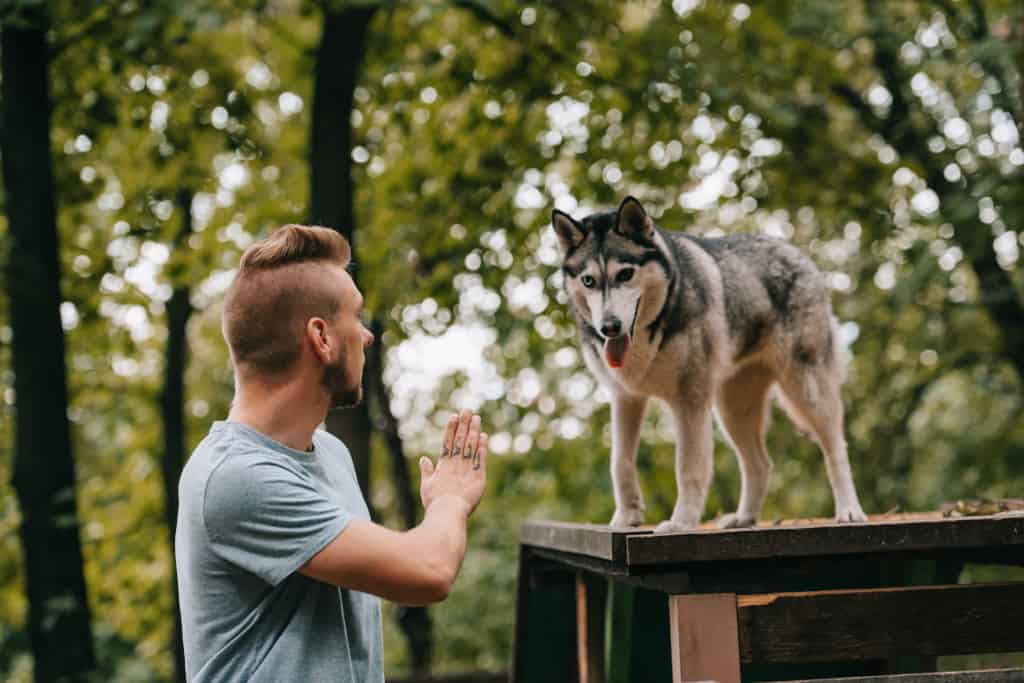
Siberian Huskies are intelligent dogs, but their independent nature can make training a challenge. They respond best to positive reinforcement techniques and a consistent training approach.
Early socialization is crucial for Siberian Huskies, as they are naturally friendly and outgoing and can become overly excitable without proper exposure to different people, animals, and environments.
It’s crucial to establish yourself as the pack leader and set boundaries early on. Huskies also have a strong prey drive, so training them to have a reliable recall is vital, especially in off-leash situations.
You May Also Like: How to Teach Your Dog Recall?
German Shepherd
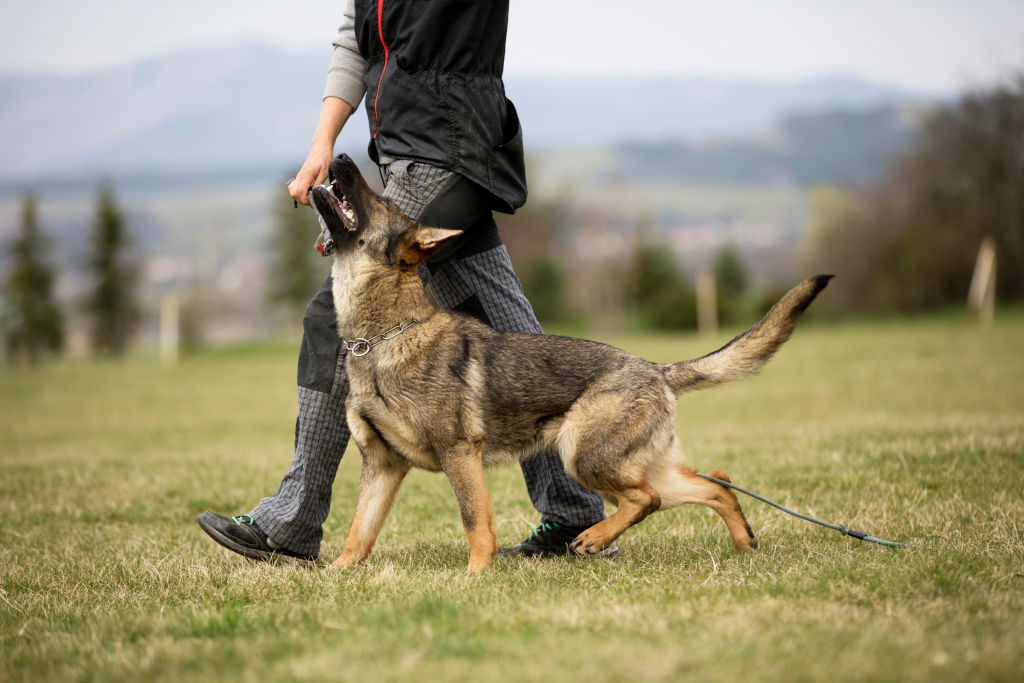
GSDs are highly intelligent and trainable dogs and can quickly learn commands and tasks. They are eager to please their owners and respond well to positive reinforcement techniques, such as treats, praise, and play.
Early socialization is essential for German Shepherds, as they can be aloof with strangers and may develop guarding tendencies if not properly socialized.
It’s also important to expose them to different people, animals, and environments from a young age to ensure they grow up to be well-rounded and confident dogs.
German Shepherds thrive on mental stimulation and enjoy activities that challenge their intelligence, such as hide-and-seek, find the treats, puzzle toys, obedience training, and agility.
You May Also Like: Best Dog Training Books: Unleash Your Pup’s Potential
| Attribute | Siberian Husky | German Shepherd |
|---|---|---|
| Ease of Training | Moderate, can be stubborn and independent | Easy, highly intelligent and trainable |
| Prey Drive | High | Moderate |
** Comparison Table: Siberian Husky vs. German Shepherd - Training and Socialization
Health and Lifespan
Siberian Husky
Siberian Huskies have a life expectancy of about 12 to 14 years. They are generally healthy dogs but can be prone to certain health issues.
Some common health concerns include hip dysplasia, cataracts, progressive retinal atrophy, and hypothyroidism. Regular check-ups and a healthy diet can help keep these issues at bay.
German Shepherd
The German Shepherd’s life expectancy is shorter than Huskies, typically between 7 and 10 years. GSDs are also healthy dogs, but like any breed, they are not exempt from health issues.
Some common health concerns for GSDs include hip dysplasia, elbow dysplasia, degenerative myelopathy, and bloat. Regular vet check-ups and a healthy diet can help keep your German Shepherd in good health and prevent these issues from arising.
You May Also Like: My Dog Refuses To Sleep, Help!
| Attribute | Siberian Husky | German Shepherd |
|---|---|---|
| Common Health Issues | Hip dysplasia, cataracts, progressive retinal atrophy, hypothyroidism | Hip dysplasia, elbow dysplasia, degenerative myelopathy, bloat |
| Lifespan | 12 to 14 years | 7 to 10 years |
** Comparison Table: Siberian Husky vs. German Shepherd - Health and Lifespan
Nutrition and Diet
Siberian Husky
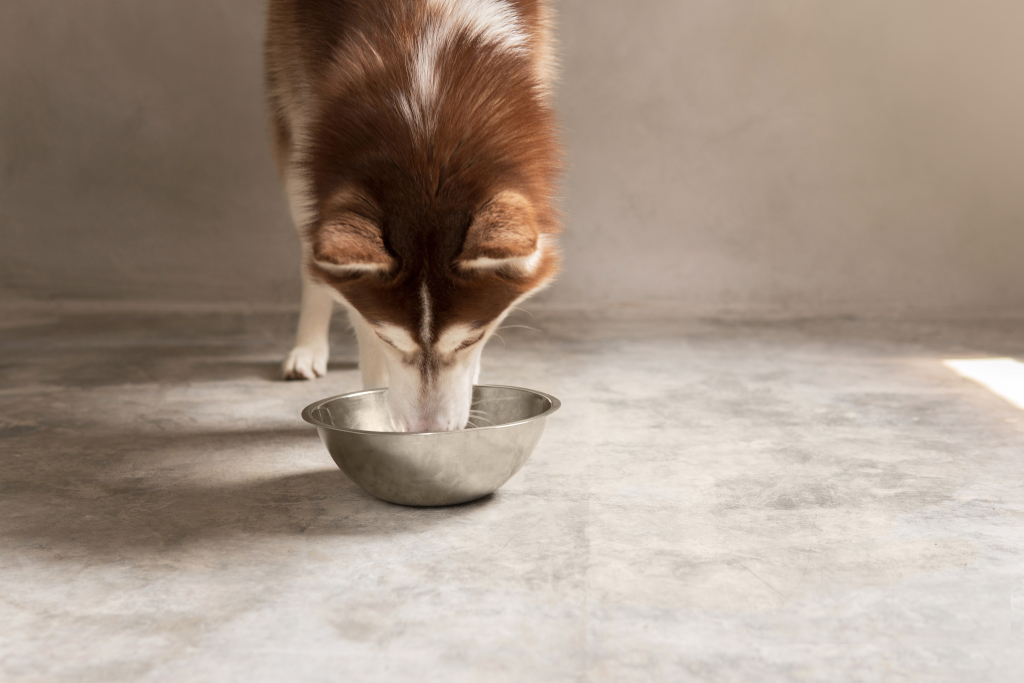
When it comes to fueling up a Siberian Husky, their dietary needs can be surprising. These energetic dogs are famous for their efficient metabolism, which allows them to do more with less.
While many dogs of similar size might consume larger portions, adult Huskies typically require only 2 to 3 cups of high-quality kibble per day, served in two meals.
It’s a testament to their ability to extract the most out of their food. But bear in mind that this isn’t a one-size-fits-all recommendation. Your Husky’s age, weight, activity level, and overall health will dictate their specific needs.
It’s always wise to consult a veterinarian to fine-tune your Husky’s diet. Their distinct metabolism and lean build make it crucial to monitor their weight and make adjustments as needed.
German Shepherd
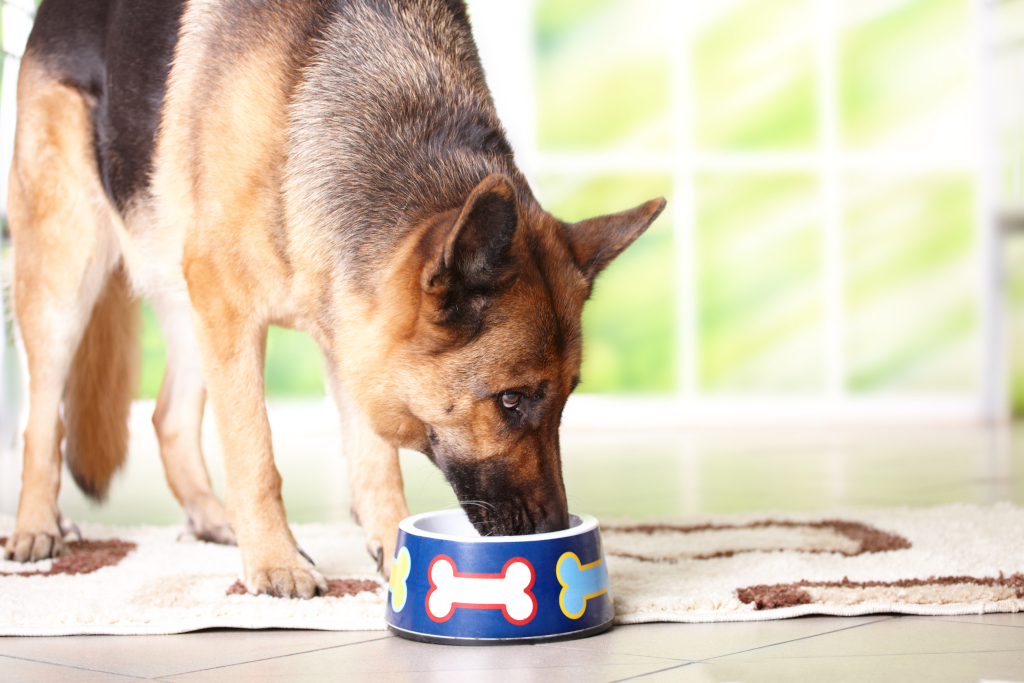
The German Shepherd is a powerhouse of a dog with a hefty appetite to match. As large, active dogs, they require a substantial amount of food to support their energy needs.
Adult German Shepherds typically need around 3 to 4 cups of high-quality kibble per day, split into two meals. They’re not just eating for size – their active nature and strong build mean they quickly burn through calories. However, as with any breed, there’s no one-size-fits-all answer.
Your German Shepherd’s needs will hinge on factors like weight, age, activity level, and overall health. If in doubt, consult with a veterinarian to determine the appropriate portion size for your German Shepherd.
You May Also Like: My Dog Refuses To Eat, Help!
| Attribute | Siberian Husky | German Shepherd |
|---|---|---|
| Average Daily Kibble Intake | 2 to 3 cups | 3 to 4 cups |
| Meal Frequency | Twice a day | Twice a day |
** Comparison Table: Siberian Husky vs. German Shepherd - Nutritional Needs
Grooming Needs
Siberian Husky
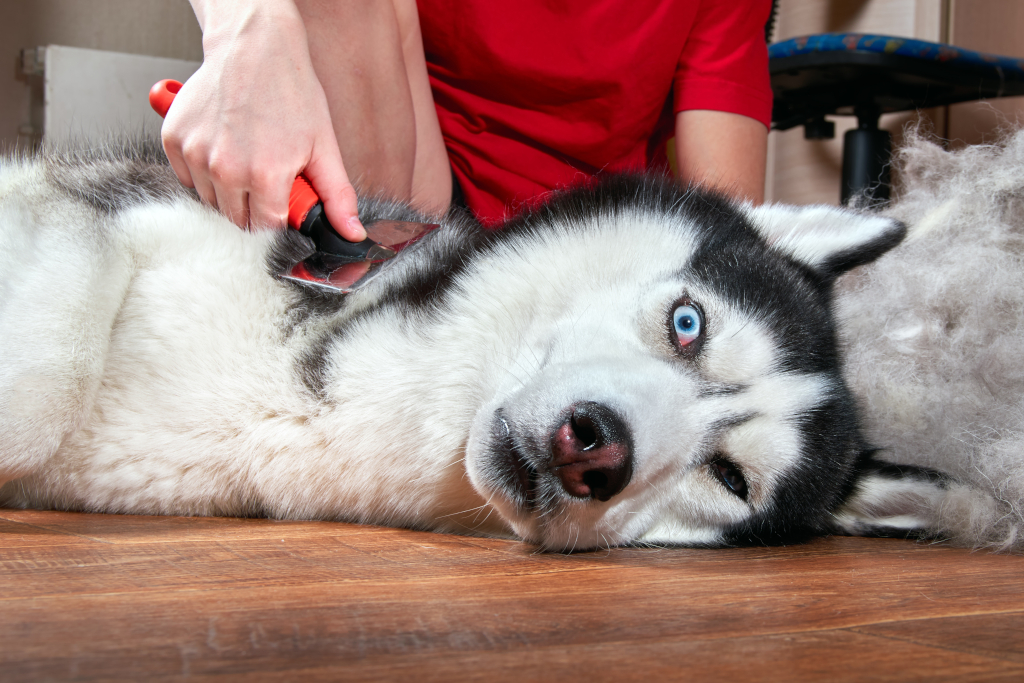
Siberian Huskies have a thick double coat, notorious for “blowing” their undercoat twice a year during the spring and fall, resulting in a flurry of shedding. During these periods, daily brushing becomes essential to handle the massive amount of loose fur and to prevent tangles and matting.
Outside of these shedding seasons, Siberian Huskies are relatively low maintenance. They are self-cleaning dogs, which require only once-a-week brushing to stay in top shape.
Bathing Huskies is a rare event, typically needed just every three to four months, as over-washing can strip their coat of essential oils. Of course, don’t forget the usual grooming routines like ear cleaning, teeth brushing, and nail trimming.
You May Also Like: Best Dog Nail Grinders To Trim Your Dog’s Nails
German Shepherd
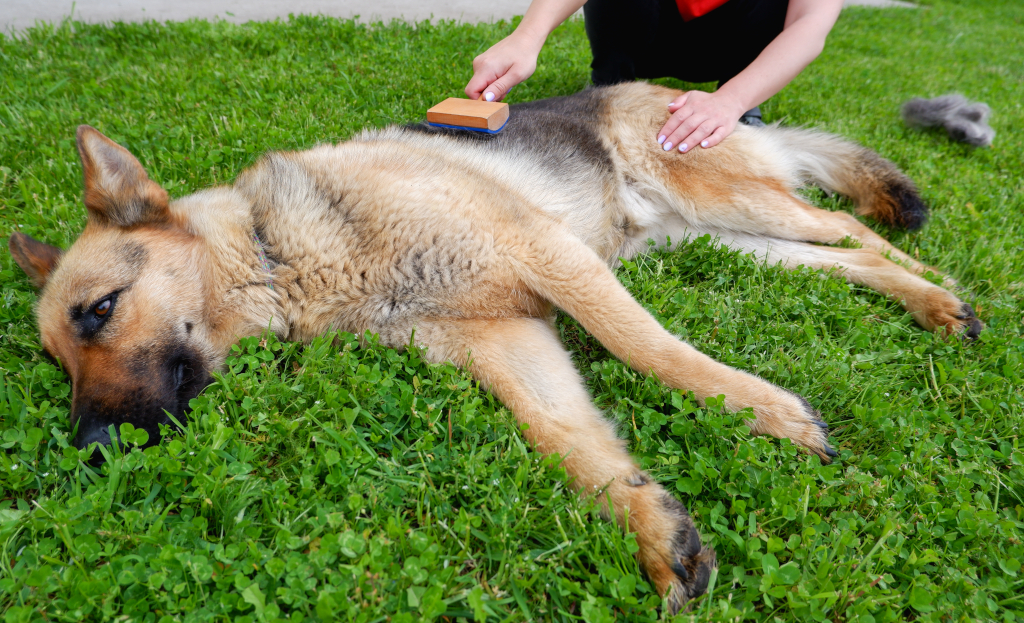
German Shepherds also sport a thick double coat but with a different grooming routine. They shed throughout the year, with a notable uptick during the spring and fall.
When the shedding intensifies, daily brushing becomes a necessity to wrangle the loose hair and prevent matting. Outside of these shedding seasons, a steady cadence of two to three times a week will keep their coat in prime condition.
Unlike the Husky, German Shepherds tend to get dirtier, warranting baths every two to three months or when they become particularly soiled. As with any breed, routine ear cleaning, nail trimming, and teeth brushing should be part of their grooming regimen.
You May Also Like: Best Dog Toothpastes To Improve Your Dog’s Oral Health
| Attribute | Siberian Husky | German Shepherd |
|---|---|---|
| Coat Type | Thick, double coat | Thick, double coat |
| Shedding | Massive shedding during spring and fall, "blowing" undercoat | Year-round shedding, peaks in spring and fall |
| Brushing Frequency | Daily in shedding season, once a week otherwise | Daily in shedding season, 2 to 3 times a week otherwise |
| Bathing Frequency | As needed, usually every 3 to 4 months | As needed, usually every 2 to 3 months |
** Comparison Table: Siberian Husky vs. German Shepherd - Grooming Needs
Suitability for Families and Lifestyle Needs
Siberian Husky
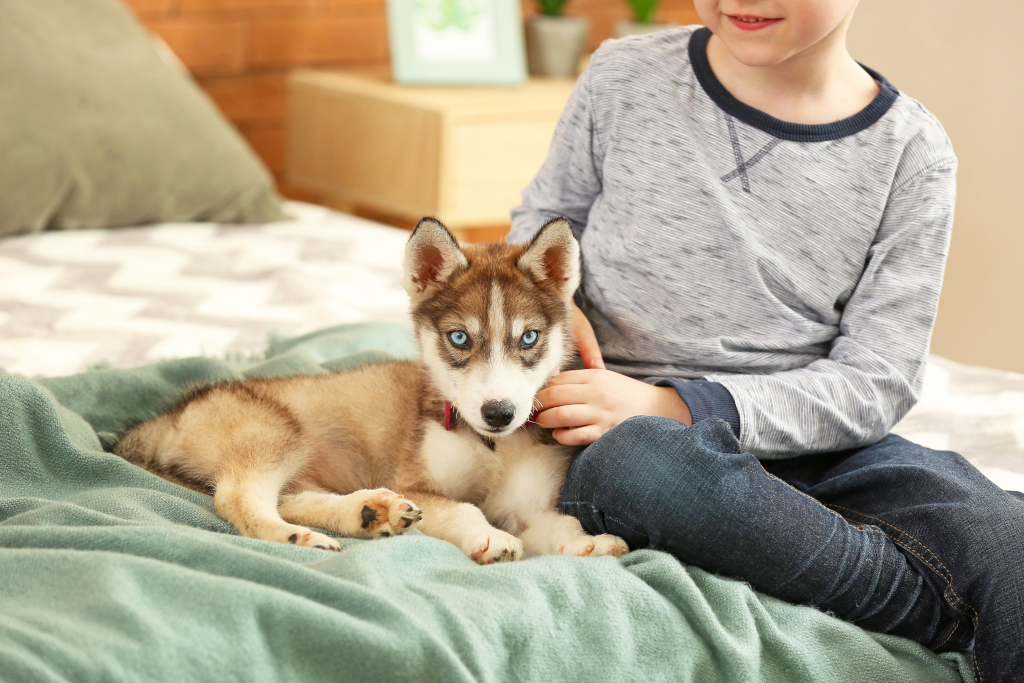
Siberian Huskies are renowned for their outgoing and friendly nature, making them wonderful companions for families. They are sociable dogs and typically get along well with children and other pets.
However, due to their high energy levels and tendency to be escape artists, they need a secure yard to play in and a family that can provide them with regular exercise and mental stimulation.
They are best suited to active families who enjoy outdoor activities and can spend a lot of time with them. Huskies can adapt to smaller living spaces if they receive adequate exercise, but they tend to thrive in homes with larger yards.
Due to their independent nature, they may not be the best choice for first-time dog owners who are not familiar with training and managing high-energy breeds.
German Shepherd
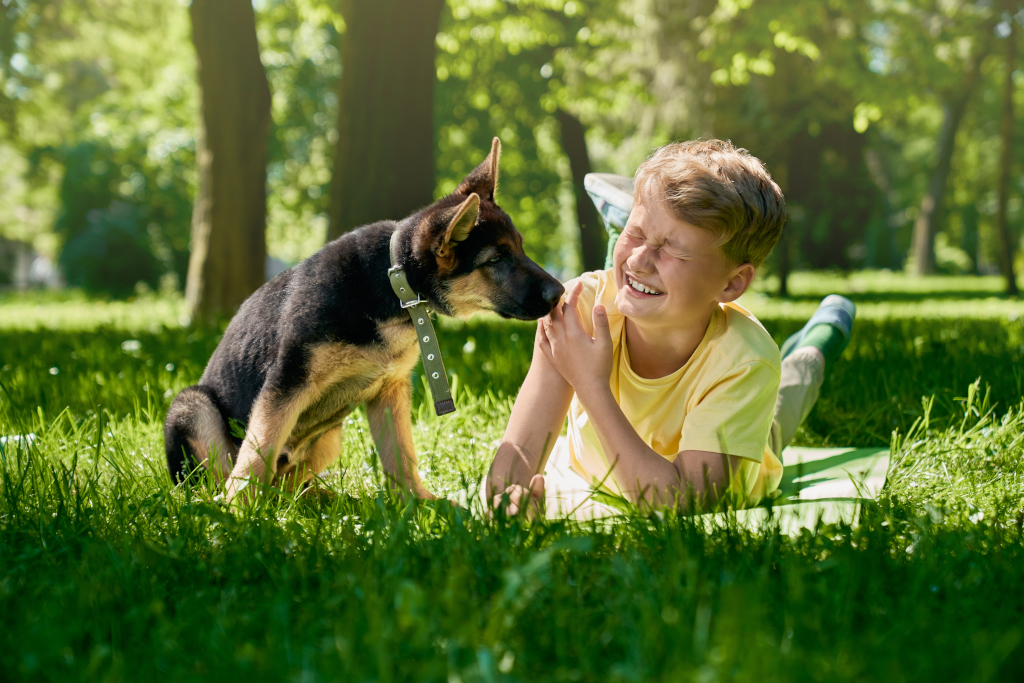
GSDs are known for their intelligence, loyalty, and protective nature, qualities that make them excellent companions for families, especially those looking for a reliable watchdog.
They are generally good with children and can be protective of them. While they may be aloof with strangers, they are typically friendly with other pets once properly introduced.
German Shepherd dogs require plenty of exercise and mental stimulation, so they are well-suited for active families and individuals.
They can adapt to smaller living spaces, but, like Huskies, they are happiest in homes with a secure yard for play and exercise.
While it’s true that they are highly intelligent and easy to train and should technically be good first-time dogs for novice owners, they require consistent and strong leadership to thrive and reach their full potential. As such, they may be better suited for those with prior dog-handling experience.
| Attribute | Siberian Husky | German Shepherd |
|---|---|---|
| Suitability for Children | Generally good with children | Generally good and protective of children |
| Suitability for Other Pets | Usually good with other pets | Usually good with proper introduction |
| Living Space Requirements | Can adapt to smaller spaces but prefers larger yards | Can adapt to smaller spaces but prefers larger yards |
| Best For | Active families with secure yards | Active families or individuals, ideally with secure yards |
| Suitability for First-Time Owners | May not be ideal due to independent nature | May not be ideal due to their need for a strong leade |
** Comparison Table: Husky vs. GSD - Suitability for Families and Lifestyle Needs
Puppy Prices
Siberian Husky
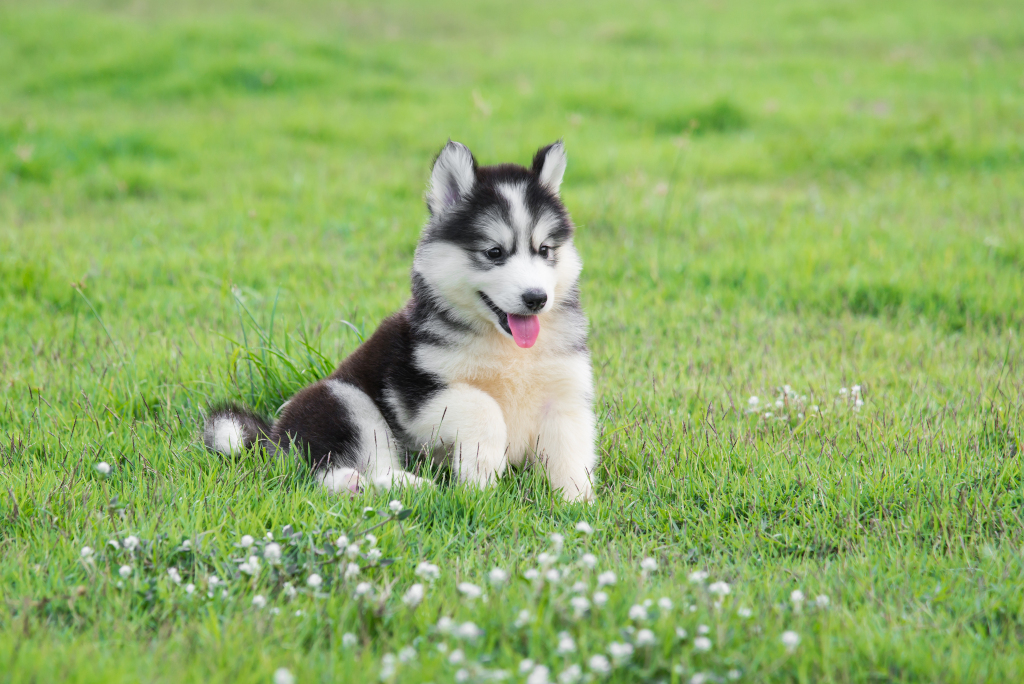
A Siberian Husky puppy typically costs between $1,000 and $2,500.
Several factors can influence the price of a Husky pup, including the breeder’s reputation, the lineage and pedigree of the parents, and the geographic location of the breeder. In general, Huskies with championship bloodlines or those bred for show may have higher price tags.
German Shepherd
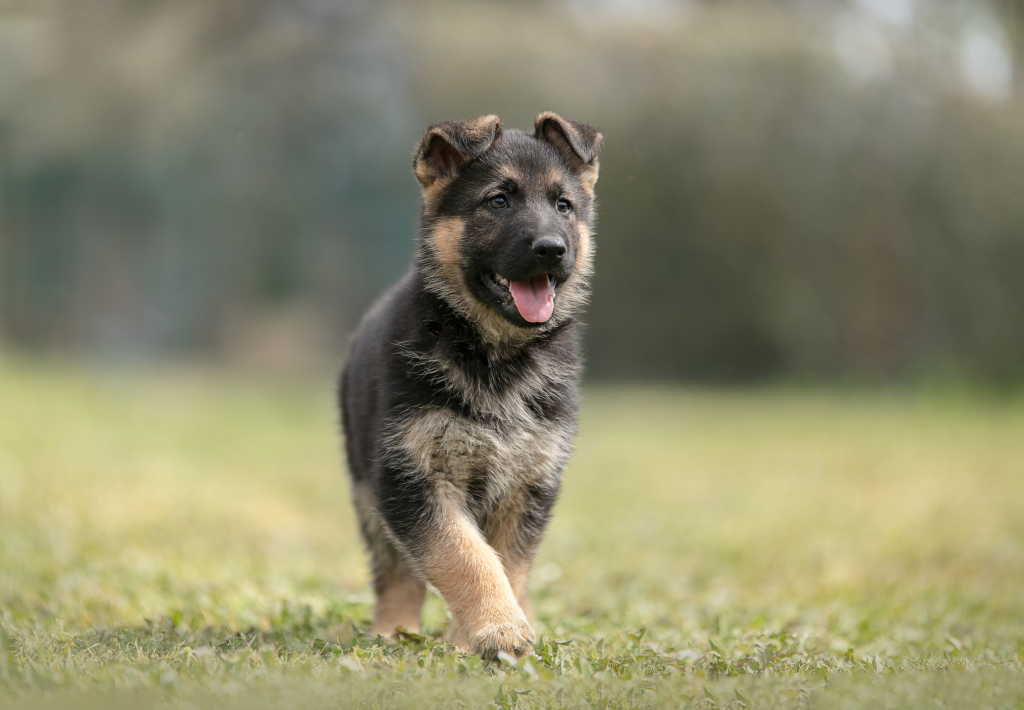
The price of a German Shepherd puppy can range from $800 to $10,000, reflecting a broad spectrum of factors that can influence their cost.
The primary reason for the wide price range is their popularity and the breeding and lineage of the puppies. German Shepherds bred for show or competition, or those with championship bloodlines, are often priced higher than those intended for companionship.
You May Also Like: Cost Of Owning A German Shepherd: Annual & Lifetime Cost
| Attribute | Siberian Husky | German Shepherd |
|---|---|---|
| Average Price Range | $1,000 to $2,500 | $800 to $10,000 |
** Comparison Table: Siberian Husky vs. German Shepherd - Puppy Prices
Note: The cost of a Husky and German Shepherd includes more than just the initial purchase price, as raising and caring for a dog involves ongoing expenses such as food, training, grooming, and healthcare.
Which Breed is Better For You? Husky or German Shepherd?
Deciding between a Siberian Husky and a German Shepherd depends on your lifestyle, preferences, and what you’re looking for in a companion.
If you’re an active person or family seeking a friendly, sociable, and energetic dog, a Siberian Husky could be an excellent choice.
On the other hand, if you value loyalty, protection, and intelligence, a German Shepherd may be more suitable.
Both breeds are good family dogs who require active owners who can give them the exercise and stimulation they need. It’s essential to consider each breed’s unique needs and characteristics before making your decision.
Regardless of your choice, you’ll have a loyal, loving companion who will bring years of joy and happiness into your life.
Frequently Asked Questions About German Shepherd vs. Siberian Husky
Q1: Is the Husky or German Shepherd more powerful?
A: German Shepherds are generally more powerful than Huskies. They are larger, have a more muscular build, and are bred for work that requires strength, such as guarding and police work. Huskies are strong in terms of endurance, but they don’t match the sheer physical power of a German Shepherd.
Q2: Are Huskies or German Shepherds better guard dogs?
A: German Shepherds are known for their guarding instincts and are often used as guard dogs, police dogs, and in military roles. They are protective, alert, and can be trained to be very effective guard dogs. Huskies, on the other hand, are friendly and sociable, making them less suitable for guarding purposes.
Q3: Do Huskies and German Shepherds get along?
A: Both Huskies and German Shepherds can get along with other dogs, including each other if they are properly socialized and introduced to each other in a controlled environment. Early socialization, training, and supervision are key factors in ensuring successful interactions between these breeds.
Q4: Which breed sheds more? Huskies or German Shepherds?
A: Both the German Shepherd and Husky are known for shedding, particularly during shedding seasons. Huskies typically shed heavily twice a year, whereas German Shepherds tend to shed more consistently throughout the year, hence why people also call them “German Shedders.” So comparing the two breeds, German Shepherds are likely to be higher shedders overall.
Q5: Which breed is easier to train? Huskies or German Shepherds?
A: German Shepherds are generally easier to train than Huskies. They are highly intelligent, eager to please, and have a strong work ethic, making them responsive to training. On the other hand, while Huskies are also intelligent, they have a more independent nature and an inherent need to explore, making them a bit more challenging to train.

